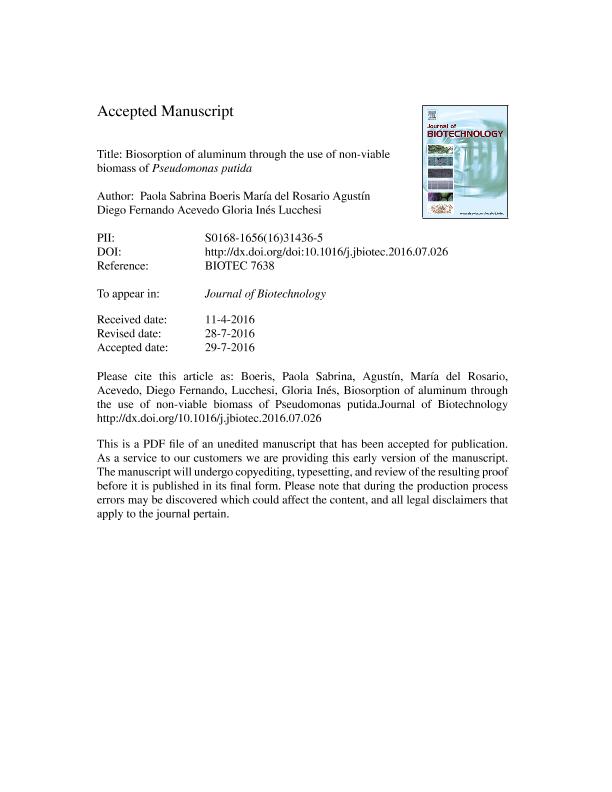Artículo
Biosorption of aluminum through the use of non-viable biomass of Pseudomonas putida
Boeris, Paola Sabrina ; Agustín, María del Rosario
; Agustín, María del Rosario ; Acevedo, Diego Fernando
; Acevedo, Diego Fernando ; Lucchesi, Gloria Ines
; Lucchesi, Gloria Ines
 ; Agustín, María del Rosario
; Agustín, María del Rosario ; Acevedo, Diego Fernando
; Acevedo, Diego Fernando ; Lucchesi, Gloria Ines
; Lucchesi, Gloria Ines
Fecha de publicación:
07/2016
Editorial:
Elsevier Science
Revista:
Journal of Biotechnology
ISSN:
0168-1656
Idioma:
Inglés
Tipo de recurso:
Artículo publicado
Clasificación temática:
Resumen
Living and non-living biomass of Pseudomonas putida A (ATCC 12633) was used as biosorbent for the removing of Al3+ from aqueous solutions. The process was stable with time, efficient at pH 4.3 and between 15 °C and 42 °C. Two isotherms models were applied to describe the interaction between the biosorbent and Al3+. Non-living biomass of P. putida A (ATCC 12633) was found to be the most efficient at adsorbing Al3+ with a maximum sorption capacity of 0.55 mg Al3+/gr adsorbent and with 36 × 105 binding sites of Al3+/microorganisms. Infrared spectroscopy analysis shows that the biosorbent present some vibrational band of functional groups that change in presence of Al3+: hydroxyl, carboxyl and phosphate. Considering that Al3+ binds to the phosphate group of phosphatidylcholine, non-viable biomass of P. putida PB01 (mutant lacking phosphatidylcholine) was used. Aluminum adsorption of the parental strain was 30 times higher than values registered in P. putida PB01 (36 × 105 sites/microorganism vs 1.2 × 105 sites/microorganism, respectively). This result evidenced that the absence of phosphatidylcholine significantly affected the availability of the binding sites and consequently the efficiency of the biomass to adsorb Al3+.
Palabras clave:
ALUMINUM
,
BIOSORPTION
,
PSEUDOMONAS PUTIDA
,
TOXIC METALS
Archivos asociados
Licencia
Identificadores
Colecciones
Articulos(CCT - CORDOBA)
Articulos de CTRO.CIENTIFICO TECNOL.CONICET - CORDOBA
Articulos de CTRO.CIENTIFICO TECNOL.CONICET - CORDOBA
Citación
Boeris, Paola Sabrina; Agustín, María del Rosario; Acevedo, Diego Fernando; Lucchesi, Gloria Ines; Biosorption of aluminum through the use of non-viable biomass of Pseudomonas putida; Elsevier Science; Journal of Biotechnology; 236; 7-2016; 57-63
Compartir
Altmétricas



